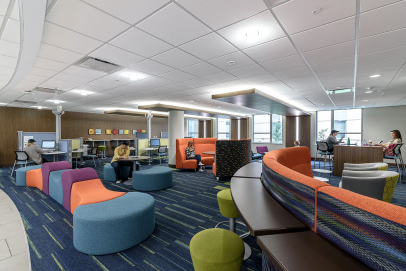Published in Interiors and Sources magazine - August 2018
By Meghan Bogener, AIA, IIDA, Project Architect and Interior Designer
Designers are witnessing an evolution in student housing interiors. While the basics of sustainability, aesthetics, and functionality remain the hallmarks of any good residence hall design, more universities today are requesting additional design elements and materials that influence student behaviors and accommodate their personal preferences and choices.
BUILDING COMMUNITY
Living/learning communities have become increasingly popular as universities strive to create smaller communities within residence halls where students who share similar interests can live, nurture relationships, and learn together within the same space. Research shows that students who feel like they are part of a community and have experienced a holistic approach to learning within a living/learning community are happier, healthier, learn more, and are more likely to successfully complete their college educations.
An important element of any living/learning community is the presence of faculty. Most living/learning communities are designed with apartments and offices for faculty members who live and teach within the community of students. When faculty play a direct role in students’everyday lives and are more humanized, students tend to feel more comfortable about approaching them and sharing their ideas and feelings, resulting in a more three-dimensional learning environment.
As a result, universities are investing in more “non-revenue” spaces within student housing and looking beyond a program based solely on filling rooms. An increasing amount of space is being dedicated in residence halls for multiple uses, where students and faculty can casually gather, share a meal, hear a lecture, or just discuss the topics of the day. Since 80 percent of college time is spent outside the classroom, universities are seeing the benefits of nurturing the student as a whole.
ENERGY-EFFICIENT TECHNOLOGY
When it comes to incorporating sustainable technology in student housing design, the trend is shifting from merely specifying energy-efficient products and materials in the building itself, to purposeful design that influences student behaviors.
Some examples of this trend include:
- Incorporating recycling areas in kitchenettes to get students in the habit of recycling
- Using meters to control shower water usage so that students get used to taking quicker showers and conserving water
- Providing cell phone charging outlets that turn off automatically when not in use to encourage students not to over-charge their devices.
- Using task and tier lighting with sensors that switch lighting on and off based on activity levels in a particular space helps students get used to turning off lighting when not in the room.
- Metering HVAC use through sensors on windows that turn air conditioners on or off if the windows are opened or closed encourages students to conserve energy.
- Designing thermostats in every room allows students to regulate their rooms based on their own preferences, not the preferences of an entire floor or wing.
GENDER-NEUTRAL RESTROOMS
Rather than having traditional “men’s” and “women’s” restrooms, universities are now designing their residence halls with clusters of private restrooms that are not based on gender. Instead of featuring a row of sinks, showers and toilets specifically just for women or for men, gender-neutral bathrooms are designed with individual, private rooms that each include four walls and a door, toilet, urinal, shower, and sink.
This design tends to be more costly because it requires more square footage and materials than a more traditional style restroom design, but it provides the greatest amount of privacy to the student.
SUSTAINABLE MATERIALS
When it comes to higher education design, sustainable material selection is playing an ever-increasing role. Since students will be in contact with materials on a daily basis, from the paint on the walls to the counter where they prepare their food and the flooring they walk on, designers are giving more consideration to material selections based on their potential impact on human health and the environment.
More than ever, higher education interiors are now utilizing products made from sustainable, recycled materials. Some sustainable options include countertops made from recycled plastic waste, carpets made from recycled fishing nets, and casework made from wheat straw.
Not only are designers seeking out sustainable, recycled materials for university interiors, but they are also basing their product selections on the sustainability of the product manufacturing process itself. Manufacturers creating products made from end-of-life materials recycled into new materials or modifying their processes to create zero waste are far more appealing these days to the designers making the decisions.
More material manufacturers are also providing Environmental Product Declarations (EPDs) that outline the life-cycle environmental impact of their products, and Health Product Declarations (HPDs) which disclose all known hazards within a product and any health risks associated with those ingredients. Just as consumers want to know where their food is sourced and prepared, designers too are interested in where and how the products they specify are being manufactured, and if there are any potential health risks.
Similar to that “new car smell”, that “new building smell” is a combination of offgassing from materials used in a building’s interior, some of which may be harmful to the occupant’s health. The focus has shifted to occupant health and the reduction of chemical contaminants that may be harmful to the environment, human health, and air quality. Designers are using more materials with low or zero Volatile Organic Compounds (VOCs) - organic chemicals that evaporate off materials and enter the surrounding air, which can have long-lasting, slow-to-develop health effects on occupants.
In the next 50 years, everyone agrees that we won’t see an end to brick and mortar buildings, and universities are certainly not going away any time soon, but what you can expect to see is a greater investment by universities in on-campus housing and non-revenue spaces for students to gather and create community. We also expect to see universities continuing the trend toward the infusion of living and learning, no matter how it may manifest itself in the years to come.





